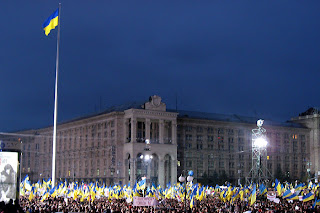 It took me some time of hesitation (exactly 2 months) whether I should make this post or not...
It took me some time of hesitation (exactly 2 months) whether I should make this post or not...I suppose everybody knows what used to be hidden under the name Auschwitz.
I've been to that place for the first time as a 13 year old girl. I remember that it was a very hot and sunny day. The area of the former concentration camp was filled with people, not much older than me at that time, wearing blue and white hoodies. All of them were Jewish teenagers from different countries, who made all the way to Poland to participate in the March of the Living, which takes place in Auschwitz every year. Despite of the young age, most of them seemed to be aware of the tragic history of the place. They were moving from one building to another and discovering over and over again what happened there not such a long time ago, putting candles in some places in memory of the victims, crying...
In the afternoon, people who gathered in Auchwitz marched all together to Birkenau, another former concentration camp, located few kilometers away. When everybody got there, it was finally possible to notice with one sight how many people were really there. A lot. Before the sunset, many speeches took place... The aim of all of them was to make all those young people remember what happened there during the World War II.
Last year, I met a girl, living in the opposite side of Europe, who visited Auschwitz during her trip to Poland few years ago. She told me that she doesn't understand making this whole big fuss over visiting the Museum of Auschwitz (yes, nowadays it is called a museum) and that she didn't feel anything at all there. For her, it wasn't shocking, terrifying or even sad visiting those buildings, rooms or showers/gas chambers where people were dying.
Lately, it happened to me to visit Auschwitz once again after 10 years. This time, it wasn't sunny. It was cloudy, cold and everything was covered with snow. It was also crowded, I believe it's always crowded there, but with many different kinds of tourists: Polish, Chinese, German, Russian, Spanish, Italian, Portuguese, Japanese, Dutch, French, British, American, Jewish, Catholic, Buddhist and so on... Each huge, medium or even tiny group had their own guide who seemed to be doing their best while telling all of the unbelievable stories.
 I don't want to point at any specific group that I've mentioned (although I could), however, I started asking myself a question: Does everybody have to visit Auschwitz during their trip to Cracow/Poland/Middle-Eastern Europe? And does it really make people remember about the World War II crimes?
I don't want to point at any specific group that I've mentioned (although I could), however, I started asking myself a question: Does everybody have to visit Auschwitz during their trip to Cracow/Poland/Middle-Eastern Europe? And does it really make people remember about the World War II crimes?I have a sad feeling that for many people it's just a tick on their list of places to visit, not a place where they learn something. Nobody should consider going to Auschwitz as a trip to the museum. It is not a touristic sight. It is a very important lesson.
I've found this worth reading article after writing my post:
"The lesson I learnt at Auschwitz"
British Prime Minister - Gordon Brown

























































